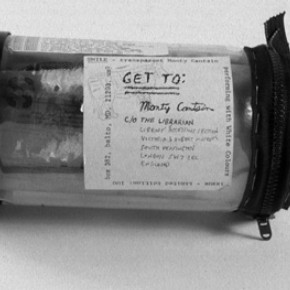Conservation Journal
Spring 2000 Issue 34
Science Surgery: The Contemporary Challenge

Figure 1. Smile: Transcript by Monty Cantsin performing with White Colours, NAL No. 992109058 (click image for larger version)
The word 'contemporary' is on everyone's lips but what is it all about and how will it affect the Conservation Department? According to the Director's Council residential held at Stilton in December 1998, the contemporary is about 'NOW'. This concept is backed up in a more practical sense by the Museum's corporate plan for 1998 - 2002, which states that at least 50% of new acquisitions will be contemporary.
As far as the Conservation Department is concerned we define contemporary as the last 10-20 years. Many objects from this period have already been acquired by various Collections and many of them have been made of synthetic polymers. Unfortunately, some of these modern polymeric objects have been the cause of conservation problems. These issues were described in an earlier edition of this Journal1.
The root of many of the problems lies in the fact that it is the nature of the plastic to degrade quite quickly in comparison to more traditional materials. Quite often the designers of these objects do not fully understand either the materials or production techniques, and experiment with both. On some occasions it is actually the artist's intention that the object will not last. Figure 1 shows an object from the National Art Library which is an example of contemporary book art. The object is an issue of SMILE (an art magazine) made in 1985 and acquired by the NAL in 1993. The artist had invited his friends to send contributions through the post, to an issue of SMILE. He then collated the contributions.
The result is a collection of transparent polyester and polyethylene leaves with images and text either printed or collaged. These were then stapled together, rolled up and placed inside a two litre polyester bottle which had a zip at the shoulder. A latex condom decorated with pictures of babies, was also placed inside the bottle. The condom had already begun to degrade when the object was acquired and small pieces of latex have collected at the bottom of the bottle and under pressure-sensitive tape. This object has been described as 'a conservator's nightmare'2, but although it is an extreme case, it does illustrate the challenges faced by a plastics conservator.
With the advent of the contemporary, we can expect an increase in the number of acquisitions made from polymeric materials. However, we are now much better prepared for them. Over the past seven years the Museum has been at the forefront of research into polymer degradation within the Collections. A survey of plastic objects in many of the Collections has been undertaken and the individual polymers most likely to deteriorate have been identified.
Preventive conservation measures have been applied with some success and investigation continues into interventive treatments. A series of educational workshops for staff on plastics and their properties is planned. Although there is no absolute solution to the problem of polymer degradation, we are now in a strong position to anticipate the potential problems associated with various materials and make more informed acquisition decisions. We must not fear modern synthetic materials but use the fruits of our research to conserve the contemporary for future access.
References
1. Keneghan,B., Plastics? - Not in my Collection, V&A Conservation Journal, No 21, 1996.
pp. 4-6
2. Talk by Jane Rutherston, Artists' Books Seminar, NAL 19th April 1995, organised by ARLIS - Art Libraries Society.
Spring 2000 Issue 34
- Editorial - A New Look For The Conservation Journal
- Contemporary V&A
- Twenty First Century Conservation
- Science Surgery: The Contemporary Challenge
- Masters Not Slaves - New Technology In The Service Of Conservation
- Difficulties In The Scientific Study of Synthetic Materials In Paints
- SIGGRAPH 99, Or Why A Conservator Should Attend A Graphics Conference
- 'My Picture Is A Sum Of Destructions', Pablo Picasso (1881-1973)
- Printer Friendly Version